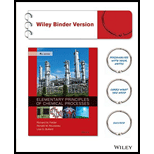
Concept explainers
(a)
Interpretation:
Plot a calibration curve using given data.
Concept introduction:
100 g of pure water and different weighed quantities of amino acid L-isoleucine (Ile) were added to six flasks to prepare aqueous solutions. Then the densities of solutions were measured using densitometer, with the following results.
| r (g Ile/100 g H2 O) | 0 | 0.8821 | 1.7683 | 2.6412 | 3.4093 | 4.2064 |
| Ρ (g solution /cm3) | 0.98803 | 0.98984 | 0.99148 | 0.99297 | 0.99439 | 0.9958 |
A calibration curve,
(b)
Interpretation:
Using the calibration curve calculate the mass flow rate of the given stream.
Concept introduction:
100 g of pure water and different weighed quantities of amino acid L-isoleucine (Ile) were added to six flasks to prepare aqueous solutions. Then the densities of solutions were measured using densitometer. Using observed data, a calibration curve was drawn and given by the formula,
Where, Ρ = density and r = concentration
In addition, it is given as,
Density = 0.994 g / cm3, Volumetric flow rate = 150 L/h
(c)
Interpretation:
If the thermocouple is poorly calibrated. Would the mass flowrate estimated in section (b) be too high or too low?
Concept introduction:
100 g of pure water and different weighed quantities of amino acid L-isoleucine (Ile) were added to six flasks to prepare aqueous solutions. Then the densities of solutions were measured using densitometer. Using observed data, a calibration curve was drawn and given by the formula,
Where, Ρ = density and r = concentration
Want to see the full answer?
Check out a sample textbook solution
Chapter 3 Solutions
Elementary Principles of Chemical Processes, Binder Ready Version
 Introduction to Chemical Engineering Thermodynami...Chemical EngineeringISBN:9781259696527Author:J.M. Smith Termodinamica en ingenieria quimica, Hendrick C Van Ness, Michael Abbott, Mark SwihartPublisher:McGraw-Hill Education
Introduction to Chemical Engineering Thermodynami...Chemical EngineeringISBN:9781259696527Author:J.M. Smith Termodinamica en ingenieria quimica, Hendrick C Van Ness, Michael Abbott, Mark SwihartPublisher:McGraw-Hill Education Elementary Principles of Chemical Processes, Bind...Chemical EngineeringISBN:9781118431221Author:Richard M. Felder, Ronald W. Rousseau, Lisa G. BullardPublisher:WILEY
Elementary Principles of Chemical Processes, Bind...Chemical EngineeringISBN:9781118431221Author:Richard M. Felder, Ronald W. Rousseau, Lisa G. BullardPublisher:WILEY Elements of Chemical Reaction Engineering (5th Ed...Chemical EngineeringISBN:9780133887518Author:H. Scott FoglerPublisher:Prentice Hall
Elements of Chemical Reaction Engineering (5th Ed...Chemical EngineeringISBN:9780133887518Author:H. Scott FoglerPublisher:Prentice Hall
 Industrial Plastics: Theory and ApplicationsChemical EngineeringISBN:9781285061238Author:Lokensgard, ErikPublisher:Delmar Cengage Learning
Industrial Plastics: Theory and ApplicationsChemical EngineeringISBN:9781285061238Author:Lokensgard, ErikPublisher:Delmar Cengage Learning Unit Operations of Chemical EngineeringChemical EngineeringISBN:9780072848236Author:Warren McCabe, Julian C. Smith, Peter HarriottPublisher:McGraw-Hill Companies, The
Unit Operations of Chemical EngineeringChemical EngineeringISBN:9780072848236Author:Warren McCabe, Julian C. Smith, Peter HarriottPublisher:McGraw-Hill Companies, The





